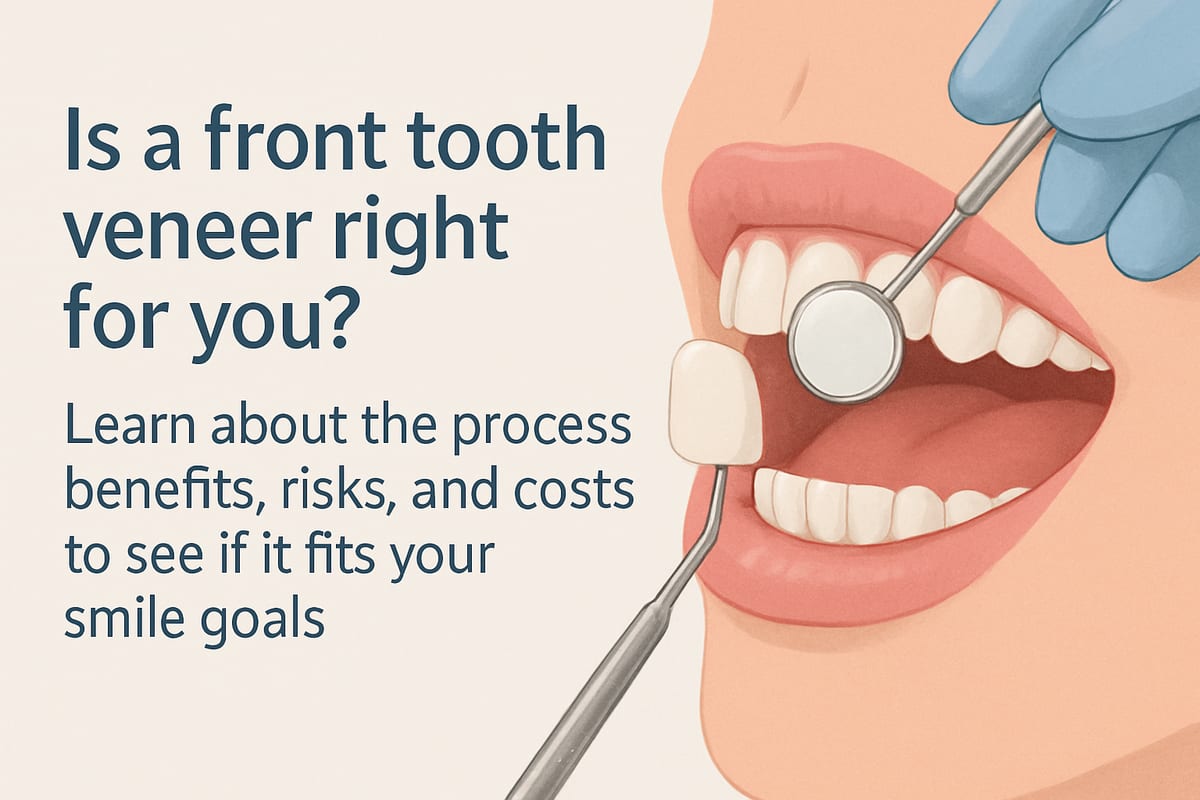Blog - [City], [state]
Tips, Facts, And The
Latest In Dentistry

What To Know About A Front Tooth Veneer: Is It Right For You?
Posted in Cosmetic Dentistry

Deciding whether a front tooth veneer is right for you starts with knowing what it does and what to expect. A front tooth veneer is a thin shell (usually porcelain or composite) bonded to the front of a single tooth to improve color, shape, or small defects. This post will help you decide if a front tooth veneer fits your goals by covering who qualifies, the treatment steps, benefits and risks, cost factors, and practical next steps.
Who is a good candidate for a front tooth veneer?
People choose a front tooth veneer for several common issues:
- Discoloration that won’t respond to whitening
- Small chips or worn edges
- Minor gaps or slightly uneven spacing
- Unwanted shape or size differences
Basic requirements include healthy gums, little or no active decay, and enough enamel for reliable bonding. Your dentist will check bite, oral health, and tooth structure during an exam.
Who might not be a candidate: heavy tooth grinders, a front tooth with a very large existing filling or root canal that lacks structure, or severe misalignment that needs orthodontics first. A clinical exam is the only way to know for sure.
What to expect during the front tooth veneer process
Consultation and planning
Your first visit includes a dental exam, photos, and often intraoral camera images. Many practices use digital smile design tools so you can preview how a veneer will look. The dentist will also review options (porcelain vs composite), take X-rays if needed, and plan the shade and shape.
Tooth preparation and placement
To place a front tooth veneer, the dentist usually removes a thin layer of enamel to make room for the shell. Then an impression or digital scan is taken. If a lab makes the veneer, a temporary may be placed while you wait. At the final visit, the veneer is bonded with dental cement and adjusted for fit and bite.
Recovery and aftercare
Short-term sensitivity is common for a few days. Care tips:
- Avoid biting hard objects or very sticky foods for a few days
- Use non-abrasive toothpaste and a soft brush
- Wear a nightguard if you grind your teeth
- Keep regular dental checkups and cleanings
Benefits, risks, lifespan, and cost factors for a front tooth veneer
Benefits of a front tooth veneer:
- Natural appearance and color match
- Porcelain resists staining better than natural enamel
- Conservative way to improve a single tooth without a crown
Risks and limitations:
- Preparation is irreversible because some enamel is removed
- Pores or thin shells can chip or debond over time
- The veneer will eventually need replacement
Lifespan depends on material and habits. Porcelain veneers commonly last 10–15 years or longer with good care; composite veneers may last 5–7 years. Factors that shorten lifespan include grinding, poor oral hygiene, and biting hard objects.
Cost drivers for a front tooth veneer include material choice (porcelain is more expensive than composite), lab-made vs same-day in-office fabrication, number of veneers needed, and any preparatory work (fillings, gum treatment, or root canal). Geographic area and the dentist’s expertise also affect price.
Alternatives and next steps — finding the right solution
Alternatives to a front tooth veneer include:
- Composite bonding — less invasive and lower cost, but stains more easily
- Porcelain crown — used when the tooth needs more structural support
- Teeth whitening — if color is the only concern and the tooth responds
- Minor orthodontics — to correct gaps or alignment before cosmetic work
- Dental implant — for a non-restorable tooth
Dental Arts of Oklahoma offers multi-location care and digital smile design tools to help patients preview results and choose the right option. Under the leadership of Dr. Soren Michaelsen, the practice blends modern technology with patient-focused care to match cosmetic choices to each person’s goals.
If you’re considering a front tooth veneer, schedule a cosmetic consultation to review your oral health, see digital previews, and get a clear recommendation for your tooth. A short exam will show whether a front tooth veneer or an alternative will best meet your needs.


